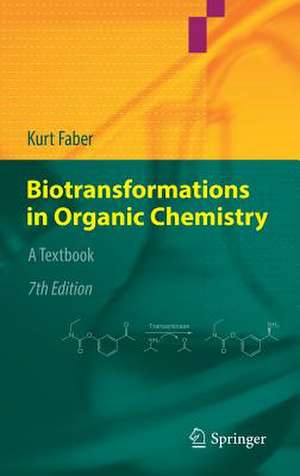Biotransformations in Organic Chemistry: A Textbook
Autor Kurt Faberen Limba Engleză Hardback – 11 ian 2018
The use of biocatalysts, employed either as isolated enzymes or whole microbial cells, offers a remarkable arsenal of highly selective transformations for state-of-the-art synthetic organic chemistry. Over the last two decades, this methodology has become an indispensable tool for asymmetric synthesis, not only at the academic level, but also on an industrial scale. In this 7th edition new topics have been introduced which include alcohol and amine oxidases, amine dehydrogenases, imine reductases, haloalkane dehalogenases, ATP-independent phosphorylation, Michael-additions and cascade reactions. This new edition also emphasizes the use of enzymes in industrial biotransformations with practical examples.
| Toate formatele și edițiile | Preț | Express |
|---|---|---|
| Paperback (1) | 591.28 lei 43-57 zile | |
| Springer International Publishing – 6 iun 2019 | 591.28 lei 43-57 zile | |
| Hardback (1) | 794.39 lei 43-57 zile | |
| Springer International Publishing – 11 ian 2018 | 794.39 lei 43-57 zile |
Preț: 794.39 lei
Preț vechi: 968.76 lei
-18% Nou
Puncte Express: 1192
Preț estimativ în valută:
152.02€ • 157.81$ • 126.76£
152.02€ • 157.81$ • 126.76£
Carte tipărită la comandă
Livrare economică 24 martie-07 aprilie
Preluare comenzi: 021 569.72.76
Specificații
ISBN-13: 9783319615899
ISBN-10: 3319615890
Pagini: 550
Ilustrații: XI, 434 p. 327 illus., 314 illus. in color.
Dimensiuni: 155 x 235 x 31 mm
Greutate: 0.8 kg
Ediția:7th ed. 2018
Editura: Springer International Publishing
Colecția Springer
Locul publicării:Cham, Switzerland
ISBN-10: 3319615890
Pagini: 550
Ilustrații: XI, 434 p. 327 illus., 314 illus. in color.
Dimensiuni: 155 x 235 x 31 mm
Greutate: 0.8 kg
Ediția:7th ed. 2018
Editura: Springer International Publishing
Colecția Springer
Locul publicării:Cham, Switzerland
Cuprins
Introduction.- Common Prejudices Against Enzymes.- Advantages and Disadvantages of Biocatalysts. Enzyme Properties and Nomenclature.- Biocatalytic Applications: Hydrolytic Reactions.- Reduction Reactions.- Oxidation Reactions.- Formation of Carbon-Carbon Bonds.- Addition and Elimination Reactions.- Transfer Reactions.- Halogenation and Dehalogenation Reactions.- Special Techniques: Enzymes in Organic Solvents.- Cascade Reactions.- Immobilization.- Artificial and Modified Enzymes.- State of the Art and Outlook.- Appendix: Basic Rules for Handling Biocatalysts.- Abbreviations.- Suppliers of Enzymes.- Commonly Used Enzyme Preparations.- Major Culture Collections.- Pathogenic Bacteria and Fungi.- Index.
Notă biografică
Kurt Faber obtained his PhD in synthetic organic chemistry at the University of Graz in 1982. He then became a postdoctoral fellow at the Memorial University of Newfoundland. After moving to TU Graz as an University assistant, Faber was a visiting senior scientist at the University of Tokyo and at Exeter University. In 1990 he received his habilitation in Organic Chemistry at the Institute of Organic Chemistry, University of Technology Graz where he was appointed to Associate Professor in 1997, in the following year he moved to the Institute of Organic Chemistry at the University of Graz where he holds a full professorship. Faber's career was supplemented by becoming a visiting senior scientist at the University of Trondheim, Stockholm University, the University of Minnesota and the ESPCI in Paris.
Textul de pe ultima copertă
This well-established textbook on biocatalysis provides a basis for undergraduate and graduate courses in modern organic chemistry, as well as a condensed introduction into this field. After a basic introduction into the use of biocatalysts—principles of stereoselective transformations, enzyme properties and kinetics—the different types of reactions are explained according to the 'reaction principle', such as hydrolysis, reduction, oxidation, C–C bond formation, etc. Special techniques, such as the use of enzymes in organic solvents, immobilization techniques, artificial enzymes and the design of cascade-reactions are treated in a separate section. A final chapter deals with the basic rules for the safe and practical handling of biocatalysts.
The use of biocatalysts, employed either as isolated enzymes or whole microbial cells, offers a remarkable arsenal of highly selective transformations for state-of-the-art synthetic organic chemistry. Over the last two decades, this methodology has become an indispensable tool for asymmetric synthesis, not only at the academic level, but also on an industrial scale. In this 7th edition new topics have been introduced which include alcohol and amine oxidases, amine dehydrogenases, imine reductases, haloalkane dehalogenases, ATP-independent phosphorylation, Michael-additions and cascade reactions. This new edition also emphasizes the use of enzymes in industrial biotransformations with practical examples.
The use of biocatalysts, employed either as isolated enzymes or whole microbial cells, offers a remarkable arsenal of highly selective transformations for state-of-the-art synthetic organic chemistry. Over the last two decades, this methodology has become an indispensable tool for asymmetric synthesis, not only at the academic level, but also on an industrial scale. In this 7th edition new topics have been introduced which include alcohol and amine oxidases, amine dehydrogenases, imine reductases, haloalkane dehalogenases, ATP-independent phosphorylation, Michael-additions and cascade reactions. This new edition also emphasizes the use of enzymes in industrial biotransformations with practical examples.
Caracteristici
Remains the established and highly cited textbook on biotransformations Includes the latest developments in this 7th edition Provides details of practical examples as well as academic references to facilitate a deeper understanding of the area More than 300 illustrations in color
